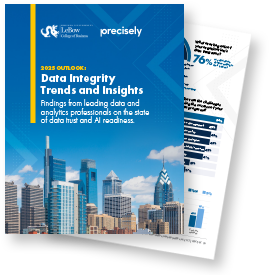You’re likely familiar with the oath witnesses must take to tell “the truth, the whole truth, and nothing but the truth.” It’s clear why “the whole truth” is included in that promise. When someone gives you only part of the story, it can distort your understanding of the facts. At best, you get an incomplete picture. At worst, you draw the wrong conclusions altogether. That, in a nutshell, is why data integrity is so important.
You should view enterprise data integrity through the same lens. When you only have a partial view of relevant information, you could be missing something important or draw conclusions that lead you in the wrong direction. At the enterprise level, that means making bad business decisions, which can have serious negative consequences.
Precisely believes that “the whole truth” is essential to data integrity. Business leaders agree. According to a 2023 study from the LeBow College of Business, data enrichment and location intelligence figured prominently among executives’ top 5 priorities for data integrity. 53% of respondents cited missing information as a critical challenge impacting data quality.
Context is essential in the quest to discover meaning and uncover business value in your data.
What is data integrity?
Ask ten people to define data integrity, and you’ll likely get different answers. Many people use the term to describe a data quality metric. Technical users, including database administrators, might tell you that data integrity concerns whether or not the data conforms to a pre-defined data model. Still, others will provide a mix of answers that touch upon accuracy, consistency, and conformance to standards. While those answers might reflect some element of the truth from a technical perspective, they fall short of explaining business data integrity in its entirety.
Precisely sees data integrity from a broader perspective. For us, it’s about your data having the accuracy, consistency, and context for you to confidently trust it for business decision-making. To be sure, data quality is a critically important part of that picture. But suppose you step back and look at the business value enterprises expect to derive from their data. In that case, you need to expand those traditional data integrity definitions.
If decision-makers and others throughout an enterprise are to trust their data fully, they need “the truth, the whole truth, and nothing but the truth.” They need a complete picture. According to the LeBow report, though, only 46% of business executives rate their level of trust in their data as “high” or “very high.”
To achieve higher levels of trust in the data, companies need reliable, scalable data integration that eliminates siloed data and allows organizations to view it holistically. They require the powerful element of location intelligence, and data enrichment from third-party sources to create even deeper context and meaning. That gives decision-makers visibility to the “whole truth” of their enterprise data.
That’s why these five elements make up Precisely’s definition of data integrity:
- Data integration
- Data quality
- Data governance
- Location intelligence
- Data enrichment
These five components provide accuracy, consistency, and context, enabling enterprises to act confidently on insights driven by trusted data.
Location matters (more than ever)
Traditional GIS analytics have a vital role in understanding location, but the value of location extends much further than that. Virtually every data element you can think of relates to a physical location in the real world. When you can match that location to other geospatial attributes, you open up a whole new world of possibilities for data analysis.
Let’s take a simple (and very obvious) example from the real estate industry. The value of a home is determined to a great extent by its size, the quality of workmanship, and the amenities it includes. But none of us would imagine pricing a home based solely on those factors. Location matters.
The quality of local schools makes an enormous difference–so much so, in fact, that two identical houses situated very close together but in different school districts might be valued very differently. Other location-based factors have a significant effect on price as well. That includes crime rates, median income levels in the region, tax rates, proximity to public transportation, and more. Without the location context, estimating a home’s value accurately is virtually impossible.
2025 Outlook: Essential Data Integrity Insights
What’s trending in trusted data and AI readiness for 2025? The results are in!

Now, let’s consider a somewhat less obvious example. Banks and credit unions develop a range of criteria for evaluating the performance of branch managers, but the characteristics of each branch vary widely. It’s unfair to compare a branch location in a busy downtown area to one in a rural community. The nuances of location extend further than that. What are the surrounding traffic patterns? How much parking is there? Are there numerous businesses in the area, and are they thriving? What does the competitive environment surrounding a branch look like?
Once you begin to consider all the factors that can impact business at a particular location, assessing the relative performance of branch managers can appear increasingly complex. Location intelligence adds context to the data about branch performance, providing a deeper and more meaningful analysis of which managers are doing well and which are not. Context makes all the difference.
Data Enrichment
Data enrichment, likewise, adds depth and context to your existing corporate data. According to IDC, 86% of senior leaders in organizations they surveyed believe that the ability to integrate and derive value from external data will be a critical competency over the next three years.
With data enrichment, enterprises can better understand their customers, competitors, and supply chains. They add depth and nuance to the information they already have. For example, insurers who offer a mix of commercial, auto, and homeowners policies can better understand which of their customers are also business owners and might represent new sales opportunities for commercial policies. They can understand family relationships and identify life events that could impact automobile policies. When a teenager reaches the age at which they may begin learning to drive, the insurer can take that opportunity to reach out and engage with their customer. The additional context of family relationships, life events, and business ownership provides rich opportunities to upsell customers, increase loyalty, and win more share of wallet.
Precisely the global leader in data integrity, in partnership with the Center for Applied AI and Business Analytics at Drexel University’s LeBow College of Business, surveyed 565 data and analytics professionals on their organizations’ data strategies, priorities, challenges and the state of data trust and AI readiness. The results are in, read the report today! 2025 Outlook: Essential Data Integrity Insights







